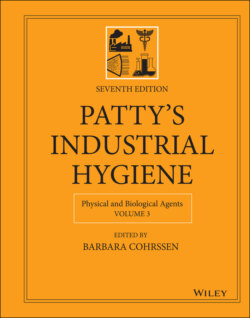Читать книгу Patty's Industrial Hygiene, Physical and Biological Agents - Группа авторов - Страница 32
6 RADIATION BIOEFFECTS
ОглавлениеQuantitatively, the harmful effects of radiation overexposure are the same whether the radiation was delivered from a source outside the body (external exposure) or from radionuclides within the body (internal exposure). The effects of a given dose are the same whether the dose was from an external radiation exposure or from an internally deposited radionuclide.
There are two qualitatively different categories of radiation bioeffects. Deterministic (or nonstochastic) effects are those for which there is a threshold dose, for which the magnitude of the effect depends on the size of the dose, and for which there is an unequivocal relationship between the radiation exposure and the effect (such as skin burns and hair loss). For deterministic effects, the threshold dose for any harmful effect must be exceeded before that harmful effect is observed. These threshold doses are very large relative to radiation safety standards. For example, the threshold dose for radiation illness exceeds 100 rads (1 Gy) of acute whole body irradiation. Threshold doses for some other effects are shown in Table 3.
The second category of radiation bioeffects is called stochastic effects, and it includes cancer and genetic effects. (It should be emphasized that, although genetic effects have been observed in experimental animals, we have observed no increase in genetic effects in any human population exposed anywhere at any time at any dose level.1) Stochastic effects occur by chance, and they occur to unexposed persons as well as to exposed individuals. Stochastic effects are therefore not definitively related to the exposure. Exposure to a carcinogen or to a mutagen increases the likelihood of expression of the effect in proportion to the size of the dose. At no time, however, regardless of the size of the dose, can we be certain that a cancer will develop. If cancer does develop, it cannot be certain that the cancer was due to the exposure. No pathologist can say with certainty that the cancer would not have occurred if the person had not been exposed to the carcinogen. The best that one can do is to calculate the probability, based on the person's exposure history and dose, that the cancer was due to the exposure. It has been observed that there are no increases in leukemia rates at acute whole body doses less than 10 rads (0.1 Gy), and no increase in solid tumor frequency at acute whole body doses of 40 rads (0.4 Gy). Nevertheless, for purposes of setting radiation safety standards, one postulates that there is a zero threshold for stochastic effects, and that the probability of a stochastic effect increases linearly with the size of the dose. This model for setting radiation safety standards is called the linear no threshold (LNT) model.
TABLE 3 Threshold doses for some clinically harmful deterministic effects.
Source: Ref. 6.
| Organ | Injury at 5 yr | 1–5% Dose | 25–50% Dose |
|---|---|---|---|
| Ovaries | Sterilization | 200–300 rads | 600–1 200 rads |
| Testes | Sterilization | 500–1 500 | 2 000 |
| Lens | Cataract | 500 | 1 200 |
| Kidney | Nephrosclerosis | 2 300 | 2 800 |
| Liver | Failure | 3 500 | 4 500 |
| Thyroid | Hypothyroidism | 4 500 | 15 000 |
| Breast | Atrophy | <5 000 | <10 000 |
| Bladder | Ulcer | 6 000 | 8 000 |
| Bone | Necrosis | 6 000 | 15 000 |
